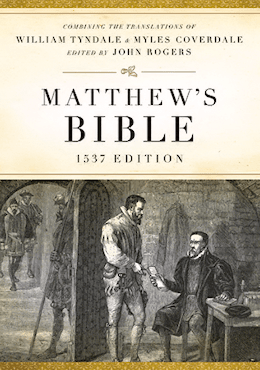Textus Receptus Bibles
Matthew's Bible 1537
| 3:1 | My brethren be not euery man a mayster, remembrynge howe that we shal receyue the more damnacyon: |
| 3:2 | for in many thinges we synne all. Yf a man synne not in worde, the same is a perfect man and able to tame al the bodye. |
| 3:3 | Beholde we put bittes into the horsses mouthes that they shoulde obeye vs, and we turne aboute all the body. |
| 3:4 | Behold also the shyppes, which though they be so greate and are dryuen of fyers wyndes, yet are they turned aboute wyth a verye smale helme, whether soeuer the vyolence of the gouerner wyll |
| 3:5 | euen so the tonge is a lyttell member, and boasteth greate thinges. Beholde howe greate a thynge a lyttell fyre kyndleth, |
| 3:6 | and the tonge is fyre, and a worlde of wickednes. So is the tong set among our members, that it defyleth the whole body and setteth a fyre all that we haue of nature, & is it selfe set a fyre euen of hell. |
| 3:7 | All the natures of beastes, and of byrdes, and of serpentes, and thynges of the sea, are meked and tamed of the nature of man. |
| 3:8 | But the tonge can no man tame. It is an vnrulye euyll ful of deadly poyson. |
| 3:9 | Therewyth blesse we God the father, and therewyth cursse wemen which are made after the similitude of God. |
| 3:10 | Out of one mouth proceadeth blessynge and curssynge. My brethren these thynges ought not so to be. |
| 3:11 | Doth a fountayne sende forth at one place swete water & bitter also? |
| 3:12 | Can the fygge tree, my Brethren, beare olyue beryes: other a vyne beare fygges? |
| 3:13 | So can no fountayne geue both salte water & freshe also. If any man be wyse and endued wyth learnynge amonge you, let hym shewe the workes of hys good conuersacyon in mekenes that is coupled with wysdome. |
| 3:14 | But, yf ye haue bitter enuyinge and strife in youre hertes, reioyce not: neyther be lyars agaynste the trueth. |
| 3:15 | Thys wysedome descendeth not from aboue: but is earthye, & naturall, and deuelyshe: |
| 3:16 | For where enuiynge and stryfe is there is vnstablenes and all maner of euyll workes. |
| 3:17 | But the wysedome that is from aboue, is fyrste pure, then peasable, gentle, and easye to be entreated, full of mercye & good frutes, wythoute iudgynge, and wythout simulacyon: |
| 3:18 | yea, & the frute of ryghtuousnes is sowen in peace, of them that maintayne peace. |

Matthew's Bible 1537
The Matthew Bible, also known as Matthew's Version, was first published in 1537 by John Rogers, under the pseudonym "Thomas Matthew". It combined the New Testament of William Tyndale, and as much of the Old Testament as he had been able to translate before being captured and put to death, with the translations of Myles Coverdale as to the balance of the Old Testament and the Apocrypha, except the Apocryphal Prayer of Manasses. It is thus a vital link in the main sequence of English Bible translations.